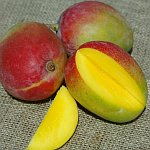|
|
 The mango is native to southern Asia, especially Burma and eastern India. It
spread early on to Malaya, eastern Asia and eastern Africa. Mangos were
introduced to California (Santa Barbara) in 1880.
The mango is native to southern Asia, especially Burma and eastern India. It
spread early on to Malaya, eastern Asia and eastern Africa. Mangos were
introduced to California (Santa Barbara) in 1880.
The mango exists in two races, one from India and the other from the Philippines
and Southeast Asia. The Indian race is intolerant of humidity, has flushes of
bright red new growth that are subject to mildew, and bears monoembryonic fruit
of high color and regular form. The Philippine race tolerates excess moisture,
has pale green or red new growth and resists mildew. Its polyembryonic fruit is
pale green and elongated kidney-shaped. Philippines types from Mexico have
proven to be the hardiest mangos in California.
The mango must have warm, dry weather to set fruit. In southern California the
best locations are in the foothills, away from immediate marine influence or
in the warmest cove locations in the California Central Valley.
The fruits are 2 to 9 inches long and may be kidney shaped, ovate or
(rarely) round. They range in size from 8 ounces to around 24 ounces.
The leathery skin is waxy and smooth, and when ripe entirely pale green or
yellow marked with red. The skin is not edible.
The flesh of a mango is peachlike and juicy with a hint of pineapple flavor.
The flavor is pleasant and rich and high in sugars and acid. The mango is the
apple (or peach) of the tropics, and one of the most commonly eaten fruits in
tropical countries around the world. The fruit is grown commercially on a small
scale in Florida. In California a large planting in the Coachella Valley has
now reached production stage.
Nutrition and consumption:
Mangoes are high in Vitamin A, and contain beta carotene. The darker orange
flesh has the most vitamin A, but without a doubt all mangoes have a lot of
vitamins and minerals. Mangoes are a good source of Vitamin C too!
Detailed nutritional informatin can be found by searching the
USDA Nutritional Database
. Enter "Mango" (no quotes) as the keyword and select the link and report of
interest.
Scientific classification:
species Mangifera indica, member of the cashew family (Anacardiaceae).
|
|